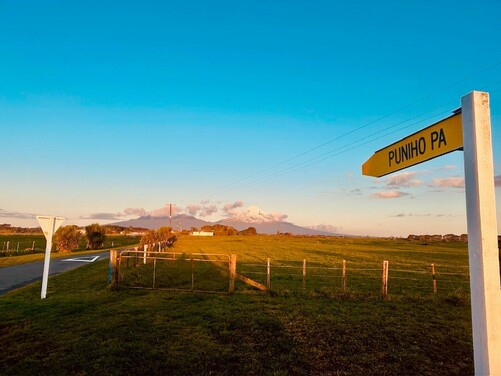Reflections from our CEO, Melissa Gibson, on the second in-person Ki te Hoe wānanga at Puniho Pā, Taranaki
There’s a heaviness in Taranaki. You feel it in the whenua, in the outlines of the pā sites, in the names etched onto signposts that still carry the echo of loss. There is an overwhelming weight in the stories of this whenua, one that does not break you but brings you to stillness, demanding that you notice, that you listen, that you feel.
At Puniho Pā, that heaviness meets generosity. The welcome was wide and open, offered even to those of us who arrived carrying little more than curiosity.
As someone who isn’t deeply spiritual, being on a marae feels as close to that as I may ever get. There’s a comfort in it. Sleeping alongside people who were strangers only a few months before, and who now feel like friends, brought with it an unexpected sense of safety and belonging.
The manaakitanga was humbling – hospitality that is both gift and challenge. How do we return such generosity in the way we live, in the way we work?
Hearing more about the Māori Battalion, and the long history of conflict from the 1860s through to the Second World War, we were given the wero: what are we prepared to sacrifice?
At St Mary’s Church, the gravestones told their own stories – but only one side. The inscriptions carry the weight of the dominant narrative, marking events from a perspective that silences others. Te Whare Hononga, the new building on the site, feels like an attempt to widen the lens, to begin correcting the record. It’s a small step towards truth-telling, but nothing can undo what was done. Acknowledging the fallen rangatira is only a beginning.
There was a serendipitous moment as we gathered outside Te Whare Hononga for a group photo. A man walked past holding a “Keep Māori Wards” sign. Without hesitation, he handed over the sign for our photo. It felt right – as if the present and past were speaking to each other in that small act.
And then Parihaka, just up the road. A story not ours to tell, but one whose weight is undeniable. So much loss, so little acknowledgement. It’s a part of our history we wish more people knew, because the silence around it still shapes us.
Even the ordinary resists remaining ordinary. Road signs and place names, bearing the weight of those with blood on their hands, become markers of memory, complicity, and silence. They remind us that colonisation is not a closed chapter of history, but something written in the present tense.
This wānanga wasn’t just about learning history. It was about carrying heaviness alongside light. About seeing how grief and resilience are woven together. About recognising that listening and witnessing are already acts of work – the work of remembering, honouring, and choosing peace again.
As we carry this wānanga forward, we are left asking: how does the Trust’s giving uphold mana motuhake to communities that have long carried the weight of loss?
How do we ensure our mahi supports and strengthens truth-telling spaces, so stories are no longer told only through the dominant lens?
The challenge for all of us is to listen deeply, to acknowledge what has been silenced, and to stand alongside those already doing the work of remembering and honouring. But our responsibility does not end there.
The future of our mahi must be strengths-based – lifting up, not weighing down. It must be empowering for Māori, grounded in mana, and alive to the possibilities of rangatiratanga. This is the work of courage and hope: to not only remember what has been lost, but to help shape a future where Māori strength, vision, and leadership shine at the centre. That is the legacy we are called to build together.
Ki te Hoe wānanga series is run by Tūmanako Consultants.

